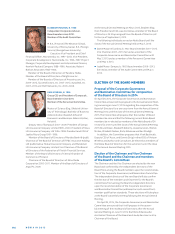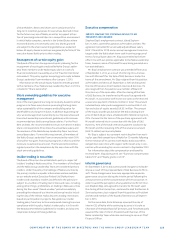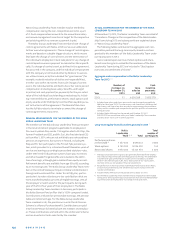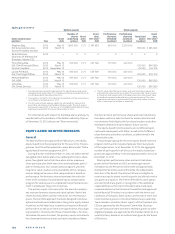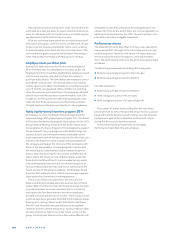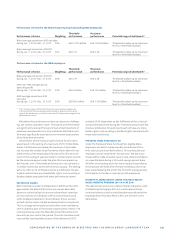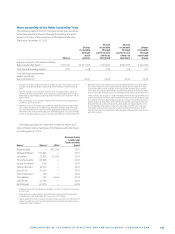Nokia 2013 Annual Report Download - page 125
Download and view the complete annual report
Please find page 125 of the 2013 Nokia annual report below. You can navigate through the pages in the report by either clicking on the pages listed below, or by using the keyword search tool below to find specific information within the annual report.123
COMPENSATION OF THE BOARD OF DIRECTORS AND THE NOKIA GROUP LEADERSHIP TEAM
of shareholders. Restricted shares were used primarily for
long-term retention purposes for executives deemed critical
for the future success of Nokia, as well as to support attrac-
tion of promising external talent in a competitive environment
in which Nokia competes, namely in the United States where
restricted shares are commonly used. Any shares granted
are subject to the share ownership guidelines as explained
below. All equity-based incentives are generally forfeited if the
executive leaves Nokia prior to their vesting.
Recoupment of certain equity gains
The Board of Directors has approved a policy allowing for the
recoupment of equity gains realized by Nokia Group Leader-
ship Team members under Nokia equity plans in case of a
fi nancial restatement caused by an act of fraud or intentional
misconduct. This policy applies to equity grants made to Nokia
Group Leadership Team members after January , .
Information on the actual equity-based incentives granted
to the members of our Nokia Group Leadership Team in is
included in “Share ownership”.
Share ownership guidelines for executive
management
One of the main goals of our long-term equity-based incentive
program is to focus executives on promoting the long-term
value sustainability of the company and building value for
shareholders on a long-term basis. In addition to granting eq-
uity, we encourage stock ownership by our top executives and
have stock ownership commitment guidelines with minimum
recommendations tied to annual base salaries. For the Presi-
dent and CEO, the recommended minimum investment in Nokia
shares corresponds to three times his annual base salary and
for members of the Nokia Group Leadership Team two times
annual base salary. To meet this requirement, all members of
the Nokia Group Leadership Team are expected to retain %
of any after-tax gains from equity programs in shares until the
minimum investment level is met. The Personnel Committee
regularly monitors the compliance by the executives with the
stock ownership guidelines.
Insider trading in securities
The Board of Directors has established a policy in respect of
insiders’ trading in Nokia securities. The members of the Board
and the Nokia Group Leadership Team are considered primary
insiders. Under the policy, the holdings of Nokia securities by
the primary insiders are public information and are available
on our website and at Euroclear Finland Ltd. Both primary
insiders and secondary insiders (as defi ned in the policy) are
subject to a number of trading restrictions and rules, including,
among other things, prohibitions on trading in Nokia securities
during the four-week “closed-window” period immediately
preceding the release of our interim and annual results includ-
ing the day of the release. Nokia also sets trading restrictions
based on participation in projects. We update our insider
trading policy from time to time and provide training to ensure
compliance with the policy. Nokia’s insider policy is in line with
the NASDAQ OMX Helsinki Guidelines for Insiders and also sets
requirements beyond those guidelines.
Executive compensation
SERVICE CONTRACT OF STEPHEN ELOP DUE TO HIS
PRESIDENT AND CEO ROLE
Stephen Elop’s employment contract, dated Septem-
ber, , covered his position as President and CEO. The
agreement provided for an annually adjusted base salary
(EUR for ) and an annual management incentive
target under the Nokia short-term cash incentive program of
% of annual base salary. Mr. Elop was entitled to the ben-
efi ts in line with our policies applicable to the Nokia Leadership
Team, however, some of his benefi ts were being provided on a
tax-assisted basis.
Mr. Elop’s employment contract was amended eff ective as
of September , , as a result of entering into a transac-
tion with Microsoft for the Sale of D&S Business. Under the
terms of the amendment, Mr. Elop resigned from his position
as President and CEO as of September , and assumed
the role of Executive Vice President, Devices & Services. He
also resigned from his position as a member of Board of
Directors as of the same date. After the closing of the Sale
of D&S Business, he transferred to Microsoft as agreed with
Microsoft. In accordance with his service contract he received
a severance payment of EUR . million in total. This amount
included: base salary and management incentive EUR . mil-
lion and value of equity awards EUR . million. The amount
of the equity awards was based on the Nokia closing share
price of EUR . per share at NASDAQ OMX Helsinki on April,
. Pursuant to the terms of the purchase agreement with
Microsoft entered into in connection with the Sale of D&S
Business, % of the total severance payment was borne by
Microsoft and the remaining % of the severance amount
(EUR . million) was borne by Nokia.
Mr. Elop is subject to a covenant restricting him from work-
ing for specifi ed competitors of Nokia for months following
the termination of his contract with Nokia. Nokia waived his
competition restriction with respect to Microsoft only in con-
nection with amending his service contract in September .
For information about the compensation and benefi ts
received by Mr. Elop during , see “Summary compensation
table ” and “Equity grants in ”.
Interim governance
On September , , Nokia announced changes to its leader-
ship as a result of the proposed Sale of D&S Business to Micro-
soft. These changes were to ensure appropriate corporate
governance structure during the interim period following the
announcement until the consummation of the transaction. In
order to avoid the perception of any potential confl ict of inter-
est, Stephen Elop, who agreed to transfer to Microsoft upon
the closing of the transaction, continued to lead the Devices &
Services business, but resigned from his position as President
and CEO and member of the Board of Directors as of Septem-
ber , .
On the same date, Risto Siilasmaa assumed the role of
interim CEO of Nokia while continuing to serve in his role as
Chairman of the Nokia Board of Directors, and Timo Ihamuotila
assumed the role of interim President and Chairman of the
Nokia Leadership Team while also continuing to serve as Chief
Financial Offi cer.





